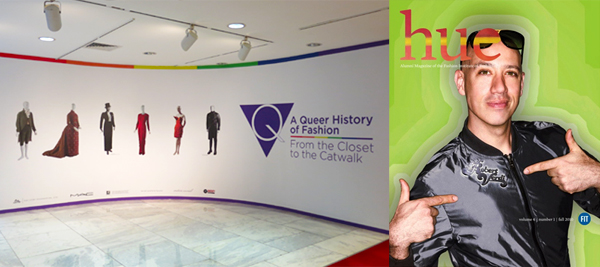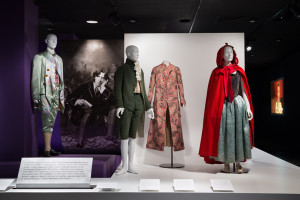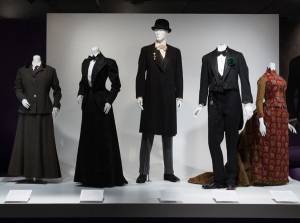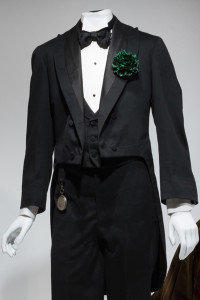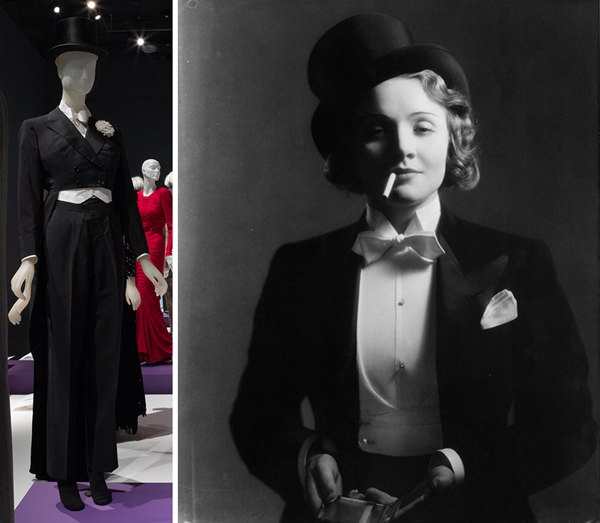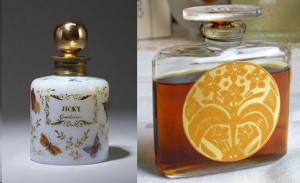That’s the power of Fashion … that it gives you the opportunity to say something before you open your mouth. I think when it’s at its most powerful, fashion tells the world who you are before you tell them who you are, which is really the defining idea behind this exhibition. – Robert Verdi
A Queer History of Fashion: From the Closet to the Catwalk, on view at The Museum at FIT now through January 4th, sets out, as co-curator Fred Dennis explains, to “honor the gay and lesbian designers of the past and present.” It explores the LGBTQ community’s influence on fashion and how members of those communities use fashion to express themselves, build identity and signal belonging in their communities. In their hands, fashion has been a tool to expose, question and challenge the boundaries of society’s norms, particularly norms of sex and gender. From Oscar Wilde and Marlene Dietrich to legions of ACT UP activists, fearless trendsetters have used fashion in their fight to forge acceptance and celebration of new ways of being. As the exhibition demonstrates, the bravery and energy of that transgression fuels a creative spirit that has helped drive innovation in the fashion industry. I had the opportunity to discuss the exhibition with one of the featured style icons, Robert Verdi — an FIT alumnus (Jewelry Design ’88). A red carpet staple, recognized by his signature sunglasses atop his head, Verdi is a pioneering television personality. Before Queer Eye for the Straight Guy, he doled out fashion advice on the Style Network’s Fashion Police and Metro TV’s Full Frontal Fashion, which he helped create. Walking through the exhibit and talking with Verdi, I was left wondering what undiscovered creative olfactory experiences could be unleashed were the fragrance world bold enough to embrace the transgressive spirit on display in the exhibition.
“Fraternity of Pretty Gentlemen” Installation View. Photo courtesy The Museum at FIT.
Pushing Boundaries: Mollies, Dandies & Les Garçonnes
The exhibit begins with the “Fraternity of Pretty Gentlemen:” proto-gay subcultures from 18th century Northern European metropolises like London, Paris and Amsterdam. The first look represents mollies, who co-curator and museum director Valerie Steele describes as “effeminate cross-dressing ‘sodomites’ who met in clubs, coffeehouses and bars also known as ‘molly houses,’ where they socialized, cross-dressed in public, and, interestingly, had ceremonies including mock-marriages.” The satin and taffeta molly-inspired look on display is comprised of women’s shoes, a petticoat, corset and a “little red riding hood.” This opening section highlighting the “fraternity” — which also includes foppish macaronis and man-milliners, “young bachelors” of the fashion industry — sets up how the borrowing of fashions across gender lines was a part of how some members of proto-gay communities resisted normative sex and gender constraints, and began to build a sense of identity.
Dandies Installation View. Photo courtesy The Museum at FIT.
Oscar Wilde, a relative latecomer to the Dandy movement, anchors the adjacent section. The dandy, Wilde has said, dared celebrate “the dangerous and delightful distinction of being different.” This style was a different form of transgression than the appropriation of style across gender lines. “The idea” of dandyism, Steele explains, “was that you paid a great deal of attention to every detail of masculine dress. It violated norms that insisted that men were not really supposed to be interested in dress.” For the dandy, it was the fastidious interest in fashion and style itself that was a form of rebellion. Talking with Verdi about the exhibition, the Wilde moment was an interesting one for him, in part because of how the exhibition juxtaposes his own style with dandyism:
Wool, 1898, possibly USA, gift of the National Trust for Historic Preservation, Lyndhurst, 2009.79.1. Photo courtesy The Museum at FIT
"I think it’s so unique in how people use fashion to either hide or stand out… to say something or say nothing… to become one of the sheep, or become the leader… You often forget that you’re a part [of it]. … I’m in this exhibition in this odd role as a kind of a modern-day Dandy, which was interesting because it’s not how I see myself. But I see how I fit into the group, and how that group expresses gayness to the world", Verdi noted.
(left) Evening suit worn by Marlene Dietrich (right) Marlene Dietrich, Morocco, 1930, photo by Eugene Robert Richee, courtesy of Deutsche Kinemathek—Marlene Dietrich Collection Berlin. Photos courtesy The Museum at FIT.
Dandyism, however, was not confined to men. Drawing from late 19th and early 20th century “Sapphic” urban subcultures, the exhibition explores how lesbians appropriated elements of men’s dress — suits, ties, starched collars— in their own self-presentation. The ‘Les Garçonnes,’ style, derived from Victor Margueritte’s controversial 1922 novel, builds on the crossing of fashion’s gender lines with styles that, as Steele describes, “tended to minimize breasts and hips, and create a kind of androgynous, boyish look.” Though fashionable beyond, the look was closely associated with lesbian subcultures. Marlene Dietrich, often referred to as “the best dressed man in Hollywood,” and her tuxedo look are displayed to represent lesbian elegance of the 1930s. Yves Saint Laurent specifically cites Dietrich’s style as inspiration for his “Le Smoking,” which stands directly behind a Dietrich tux. Verdi highlights the boldness of these statements, noting that at the time, “all women were wearing dresses and skirts. No women were wearing suits, but, at this particular moment, you found that here is a group of women who were challenging the standards of dress for women… and many of them were lesbians.” While the dandy movements were by no means exclusively LGBTQ affairs, they were closely associated with these subcultures. They were, again, exercises in the use of fashion to press up against the boundaries of accepted norms of masculinity and femininity to try to create space for new styles of being.
Vintage Guerlain Jicky (1889) and Vintage Caron Tabac Blonde (1919
Thinking about fragrance at this time, there were not distinct masculine and feminine traditions against which one could transgress. Rather, these distinctions were only beginning to be created. The late 19th century is often described as the beginning of modern perfumery, thanks to the discovery and incorporation of man-made materials. Two fragrances in particular, Houbigant’s Fougère Royale (1882) and Guerlain’s Jicky (1889), inaugurate the birth of modern perfumery. Jicky was known to be popular with Dandies, but, at the time of their launch, neither was directly called out as being “masculine” or “feminine.” Those types of descriptions only became more common during the postwar period. However, in the interwar period, there were rumblings of a “feminine type” of fragrance, which explored three new olfactive directions: the chypre, the oriental, and the floral aldehydic. Tabac Blonde (1919), Caron’s ode to the smoking woman, is a beautiful leather chypre punctuated with tobacco that perfectly encapsulates the style of ‘Les Garçonnes.’ Guerlain’s classic oriental fragrance, Shalimar (1925), typifies the Belle Epoque era obsession with the Orient through a combination of citrus, florals, resinous vanilla, and civet: warm, sensual, and just a little dirty. Lastly, the floral aldehydic powerhouse Chanel No. 5 (1921), simple and elegant, was a fragrance that perfectly matched the modern ease and sophistication of Chanel’s designs, themselves a reflection of modern femininity. While women were exploring “feminine” fragrance types introduced into the world of perfume, the new home shaving market began to introduce men to a distinct olfactory experience. The fougère, along with citrus-based tonics and after shaves, became popular olfactive choices for scenting men’s grooming products. Where fashion in this period was the site for the transgression of gender norms, in fragrance, those norms were only beginning to be established.
–Douglas Bender, Contributor and Founder of Charenton Macerations
Editor's Note: When I learned of FIT’s Queer History of Fashion exhibition through Robert Verdi's publicist, I thought Douglas Bender, who has a Master’s Degree from FIT in Cosmetics and Fragrance Marketing and Management (Class of 2007) would be the perfect person to cover the event for CaFleureBon. Douglas created the brand Charenton Macerations, which refuses to be bound by the fragrance world’s traditional gender archetypes in its olfactive storytelling. His analysis of the exhibition shows how fashion’s rich history of political and pleasurable play with gender norms has driven creativity and innovation in the industry. In contrast, the noticeable absence of a similar history in fragrance presents a wonderful opportunity for new experiments with fragrances that have yet to come. In Part Two, he examines the Postwar period, Stonewall and the impact of the AIDS crisis in the 1980s. The Final Part will bring the history up to today. CaFleureBon would like to thank Douglas for an extraordinary series, as well as extend our sincere thanks to Robert Verdi, and co-curators Fred Dennis and Valerie Steele. –Michelyn Camen, Editor in Chief
For more information on Douglas and his work at Charenton Macerations, check out Mark’s review of Charenton Macerations’ Christopher Street (in collaboration with Perfumer Ralf Schwieger) and our Profiles in American Perfumery Series

